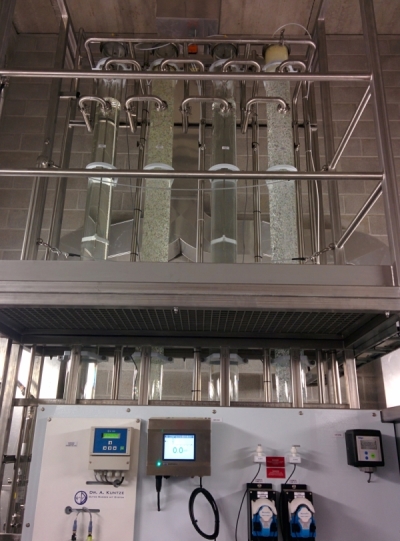A team of University of Toronto (U of T) researchers are using the cutting-edge equipment supported by the Southern Ontario Water Consortium (SOWC) to propel innovative drinking water technologies into the hands of industry and government.
Led by top water experts Bob Andrews, Ron Hofmann and Susan Andrews, the Drinking Water Research Group (DWRG) involves up to 35 U of T researchers and staff who work with partners from industry and government on a wide range of projects related to drinking water treatment optimization.
“We serve as a bridge to bringing newer, more advanced technologies into practice,” says Bob Andrews. “Utilities can’t often go out on their own and test the latest technologies and a majority of water-related researchers are well positioned to conduct fundamental work. We help introduce innovative technologies to the drinking water industry.”
The research team works with several dozen utilities from across the province on a regular basis, adds Bob Andrews.
“Partnerships are important when it comes to advancing new technologies. It allows us to put them into the hands of the end user and educate them on potential applications. We are always welcoming new partnerships.”
In addition to their expertise as engineering professors, Bob Andrews holds an NSERC Industrial Research Chair in Source Water Quality Monitoring and Advanced/Emerging Technologies for Drinking Water Treatment, Ron Hofmann holds an NSERC Industrial Research Chair in Technologies for Drinking Water Treatment, and Susan Andrews is the SOWC’s Drinking Water Node leader.
“Through the Drinking Water Node, SOWC has provided us with a number of tools and we use the equipment in almost everything we do,” says Susan Andrews. “The infrastructure supported by SOWC is extremely important and fundamental to a majority of our projects.”
One of the main pieces of equipment provided by SOWC is the Mobile Advanced Oxidation Process Platform, which contains custom treatment units such as UV, ozone or solar energy on mobile skids to allow for transportation to field sites. The advanced oxidation processes are evaluated for the ability to remove or neutralize emerging contaminants, both chemical and microbiological.
In collaboration with the City of Peterborough, the research team is using the pilot platform to study the impact of using ozone to break down or remove organic matter in the water so that it is easier to treat downstream. For this study, the pilot platform is currently set up in the municipality’s drinking water treatment plant.

University of Toronto Ozone Pilot in use at the Peterborough Wastewater Treatment Plant. Copyright: University of Toronto
In addition to its benefits for research purposes, the pilot platform is also helpful for municipalities that are considering installing advanced oxidation in their plants, he adds.
“This piece of equipment enables them to have a way to test it out.”
Although they are only in their first year of the five-year study, the re-search team has already discovered that treating the water with ozone significantly reduces the amount of disinfection required downstream.
“The ozone serves as a great oxidant and is better at reducing organic matter,” says Bob Andrews.
The DWRG has also worked with York Region municipality. For this project, the research team was examining ways of making the ultraviolet advanced oxidation process more cost-effective when it comes to destroying chemicals from pharmaceuticals and personal care products in the water by testing a variety of pretreatment methods.
“We know UV advanced oxidation works to destroy these chemicals but it can be an expensive treatment process,” says Ron Hofmann. “We want to find a way to decrease the cost by pretreating the water beforehand.”
For this project, the DWRG used the SOWC pilot-scale UV reactor as well as its laboratory UV reactor.
“The pilot scale reactor is close in size to a full-scale device so we were able to simulate the scale of an actual treatment plant,” says Hofmann. “This allowed us to take what we had tested in the laboratory and validate our findings in the field.”
Some of the pretreatment techniques the researchers used involved organic matter removal through coagulation and setting as well as activated carbon absorption.
While more research needs to be done to refine the process, Hofmann says finding ways to reduce the costs of treatments like the UV advanced oxidation process are important in terms of encouraging industry and government to utilize these types of effective water technologies.
“By pretreating the water we can make the advanced oxidation process less expensive because it will require less energy and less chemicals to clean the water,” says Hofmann. “Chemicals from pharmaceuticals and personal care products aren’t regulated so there is no motivation for municipalities to control them and currently it would be costly for them to do so. But if we can find a way to reduce the cost, then perhaps municipalities would be more motivated to install systems that destroy these chemicals.”
Another SOWC-funded piece of equipment that is being put to good use by U of T’s DWRG is the solar simulator.
“It allows us to use the sun to do advanced oxidation, which is essentially the cheapest energy source you can get,” says Susan Andrews.
In this study, the researchers are using chemically-modified titanium dioxide to degrade chemicals and disinfect water. They added nitro-gen and iodine to make the titanium dioxide more sensitive to visible light. The water is then exposed in the solar simulator, which is a light that mimics natural sunlight, to see how effective the combination of all three are at treating water.
“This treatment process is aimed at smaller more remote locations where you have long-term storage of water,” says Susan Andrews. “Instead of having the standing water go through a more expensive process, maybe we can simply add some form of titanium dioxide, take the roof off the tank and expose it to the sun. We are hoping this treatment process could be used as a more cost-effective way to treat industrial wastewater or even drinking water.”
Ultimately, the goal of the DWRG is to find technologies that will result in more efficient and cost effective ways to treat drinking water, says Bob Andrews.
“By pooling our resources and having access to a wide breadth of infrastructure, we can cover a broad spectrum of treatment options and evaluate state-of-the-art equipment for adoption by industry and government.”


